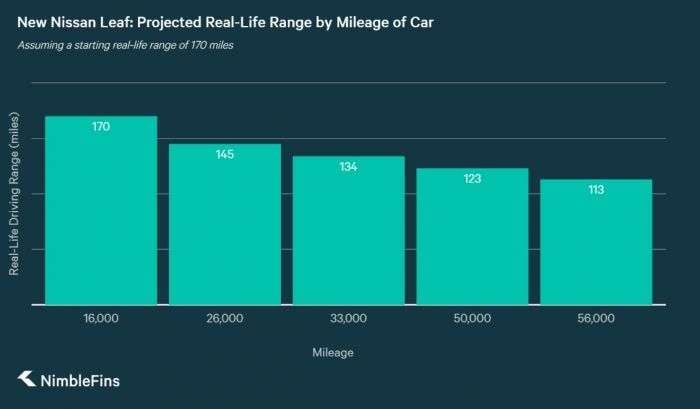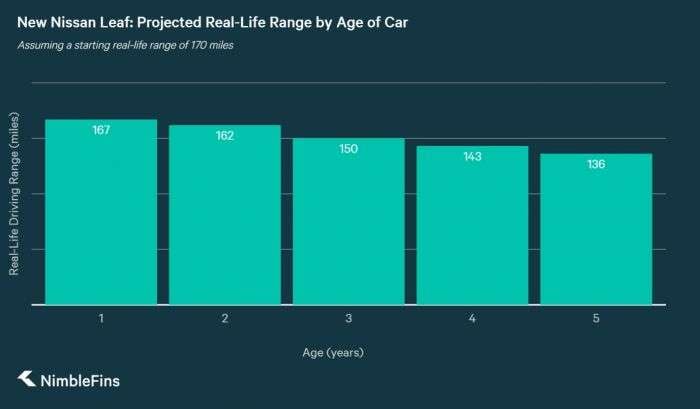The new 40 kWh Nissan Leaf, with its larger battery, sports an estimated real-life driving range of around 170 miles depending on conditions. This 33% increase in maximum range over previous models is certainly a welcome upgrade to those worried about driving longer distances in an EV. However, many drivers still have questions about EV range, especially when it comes to future battery deterioration.
Will their Leaf deliver fewer miles on a full charge when it’s older? What real-life driving range should motorists expect as their Leaf racks up the miles and years?
To help provide some colour around these important questions of battery and range deterioration, consumer-research site NimbleFins has analysed data submitted by real Nissan Leaf drivers from around the world to Plug In America, a non-profit, supporter-driven advocacy group. Over a thousand data points collected between 2012 and 2017 reveal what Leaf owners have actually experienced in terms of battery deterioration and, consequently, range deterioration.
In their study, NimbleFins used this data to project what owners of the new 40 kWh Leaf can expect in terms of driving range over the lifetime of car ownership.
Here’s How Nissan Leaf Range Drops with Mileage
Generally speaking, as an EV accumulates more miles on the odometer the real-life driving range will slowly drop. Why? The largest contributing factor to battery deterioration is the number of charging cycles. So, a car with higher mileage (achieved through more charging cycles) will have a shorter range due to battery deterioration. You’ve probably noticed a similar pattern with your cell phone – after a few years of use and charging, the battery just doesn’t last as long as it did when it was new.
The historical data show that Leaf models with the bar-style battery display had, on average, dropped from 12 battery capacity bars down to 9 bars upon the car reaching 50,000 miles on the odometer, as you can see in the following table of average 2012 – 2017 Leaf battery capacity by car mileage.
Battery Capacity Bars Remaining and Average Mileage
- 12 Bars - 16,148
- 11 Bars - 25,987
- 10 Bars - 32,677
- 9 Bars - 49,631
- 8 Bars - 55,572
Given the first battery bar represents a 15% loss in range, and subsequent bars a 6.25% loss, this history was projected onto the new Leaf with its estimated 170 mile, real-life starting range. Doing so, NimbleFins estimated that new Leaf drivers will get around 120 miles of range from a car with 50,000 miles on the odometer, as you can see in the following chart:

Here’s How Nissan Leaf Range Drops with Age
In a similar fashion, it’s possible to estimate how far the new Nissan Leaf will drive on a full charge according to the age of the car. First, analysis of the historical PlugIn America data from 2012 to 2017 shows that the batteries on most five-year-old Leafs were down to 10 out of 12 bars, as you can see in the following table.
Car Age and Average Number of Battery Bars
- 1 year - 11.9
- 2 years - 11.7
- 3 years - 11.2
- 4 years - 10.9
- 5 years - 10.1
How does these results apply to the new 40 kWh Leaf? Using a linear approximation for fractional bars, NimbleFins estimated that when the average new Nissan Leaf turns 3 years old, it will offer 150 miles of range, as you can see in the following chart. Cars aged 5 years old should still provide over 130 miles of range from a full charge.

When the Estimates Might Fail
While we expect these results to hold true for the average car, there are circumstances when the battery deterioration might prove to be noticeably worse. For instance, those driving significantly more than average each year will probably notice a worse real-life range vs. other cars of the same age. This would be due to a higher number of battery charging cycles over the life of the car. By covering more miles, the battery would have been charged more often, deteriorating more quickly and therefore offering a shorter real-life driving range.
How to Get More Leaf Range
As your car ages it can be even more important to know tricks for extending the range such as driving evenly (e.g., without quick accelerating) and not using the air conditioning. For instance, Torque News’ recent study of various Leaf discussion boards showed that turning on the air conditioning could cause a range drop anywhere from 3 miles up to 20 miles, or 15 to 20 percent, depending on the car and outside weather conditions.
If you have an older model Nissan Leaf, you may be able to extract an extra 10% or so of range by adding a Leaf Box.
Potential Leaf drivers who are concerned about how far their car will drive as it ages might want to consider leasing a car instead of buying outright. That way, when the car is, say, three years old you can just hand it back to the dealer and move on to the latest model, if you want. To learn more, you can read a discussion of buying vs leasing the new 2018 Nissan Leaf here.
Methodology of Nissan Leaf Range Study
NimbleFins gathered data on the age, mileage and battery capacity bars of Nissan Leaf cars from Plug In America’s Leaf survey, in which actual car owners around the world self-report real-life car stats. The data covers cars built between 2011 and 2017, of various age and mileage. NimbleFins then analysed the information which covered over a thousand entries across 564 cars, in order to understand the relationship between battery capacity bars and the age and mileage of a car. Projections were then calculated for the new 40 kWh Nissan Leaf assuming that, despite the change in the way battery capacity is displayed in the 2018 model, the 40 kWh Leaf is expected to deteriorate in the same manner as older Leaf models.












Comments
It's like comparing oranges
Permalink
It's like comparing oranges to apples. The battery formulations changed over time, as well as charging profiles, changing their heat tolerance and degradation. Early 2011/12 models had significantly more degradation than 2013-2015 (and early 2016) models.
2016 introduced the 30kW packs, which had a different set of issues, which is speculatedly related to the charge profile not slowing down the charge even when the battery is very hot during DCFC. Higher density in the packs also meant it didn't cool down as fast either.
2018 introduced the 40kW packs and now has better temperature control when the pack is very hot, leading to slower DCFC charging (and subsequently should lead to better durability of the battery, and reduced degradation).
So you can't compare the 2018 to previous models. It's very different in each iteration of the LEAF. A degradation model in one iteration does not work with another.
It’s puzzling that the
Permalink
It’s puzzling that the NimbleFins would put so much effort into the study yet completely ignore/miss the battery chemistry change, and other changes of 2013-15 that seem to have radically improved longevity.
actually, the data seems to
Permalink
actually, the data seems to show that the newer 30 Kwhr battery has significantly worse degradation issues
This is wrong. I have a 2015
Permalink
This is wrong. I have a 2015 leaf with 42thousand miles with 12 bars 94.3% health. So similar to other comments here you are not considering major factors in chemistry advancements year on year. In fact here in the UK. My friends have 80thousand plus miles on there 24kwh Leafs with 12 bars still.
I live in Auckland New
Permalink
I live in Auckland New Zealand and have a 2017 40KWH Leaf that I got as a Japanese import. It has now done 26000 Kilometers ( I think that is about 16000 miles) and so far there is no loss of range or noticeable degradation of the battery. I am still getting the as new range from the car, but rapid charging is slow. 30 kwph max which is lower than cars that were not originally made for the Japanese market.